Managerial Accounting Case Study Analysis Report - HI5017
VerifiedAdded on 2023/04/04
|14
|2775
|149
Report
AI Summary
This report analyzes managerial accounting case studies, fulfilling the requirements of the HI5017 unit at Holmes Institute. The assignment begins with an introduction to cost concepts and their application, followed by an in-depth analysis of a childcare business. This includes calculations related to fixed, variable, and relevant costs, as well as recommendations on operational decisions. The report then critiques a journal article on innovation management and concludes with a comparative case study of Canon Inc. and Apple Computer Inc., focusing on their managerial accounting systems. The analysis covers decision-making processes, the impact of accounting information, and the application of cost concepts in real-world business scenarios. The report aims to demonstrate a strong understanding of managerial accounting principles and their practical applications in diverse business contexts.
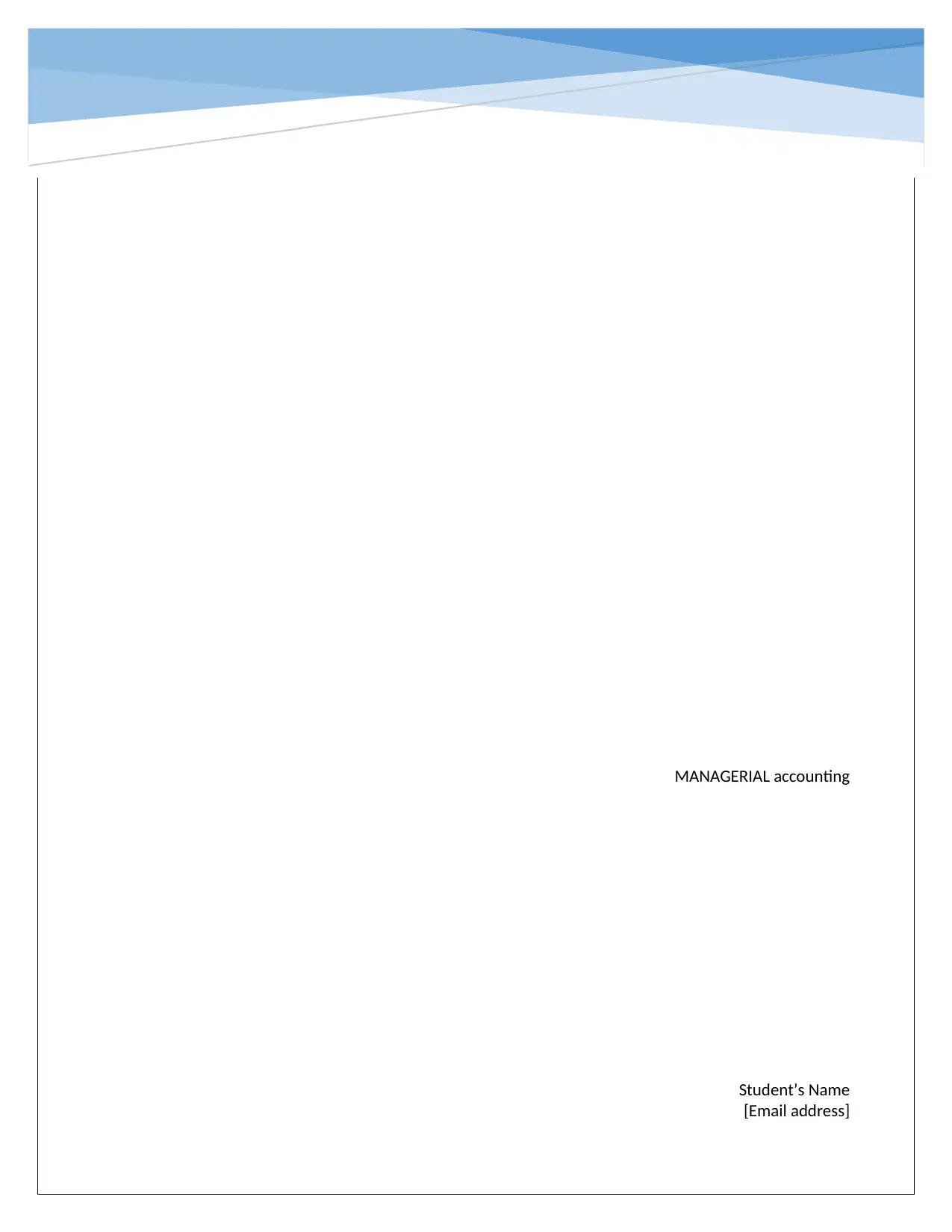
MANAGERIAL accounting
Student’s Name
[Email address]
Student’s Name
[Email address]
Paraphrase This Document
Need a fresh take? Get an instant paraphrase of this document with our AI Paraphraser
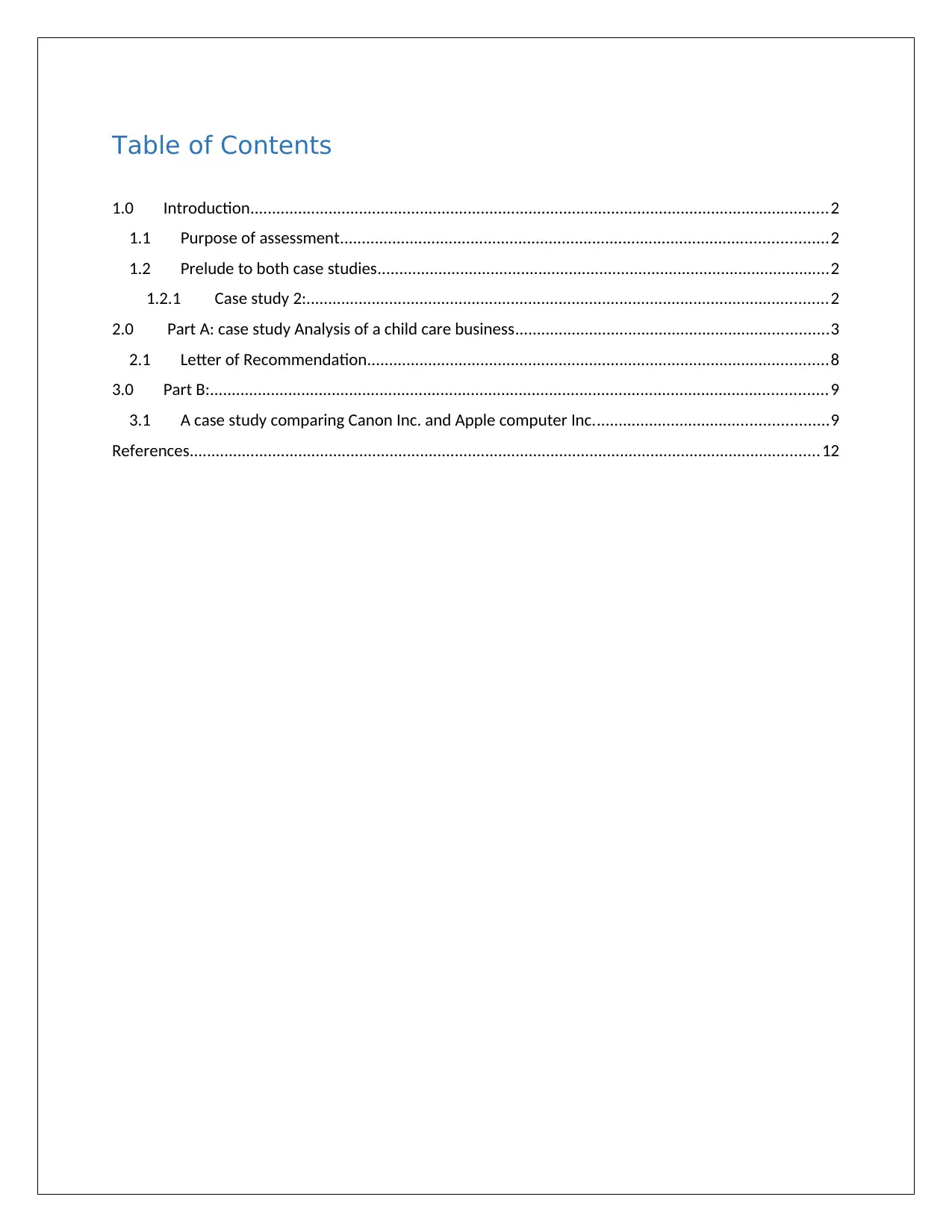
Table of Contents
1.0 Introduction.....................................................................................................................................2
1.1 Purpose of assessment................................................................................................................2
1.2 Prelude to both case studies........................................................................................................2
1.2.1 Case study 2:........................................................................................................................2
2.0 Part A: case study Analysis of a child care business........................................................................3
2.1 Letter of Recommendation..........................................................................................................8
3.0 Part B:..............................................................................................................................................9
3.1 A case study comparing Canon Inc. and Apple computer Inc......................................................9
References.................................................................................................................................................12
1.0 Introduction.....................................................................................................................................2
1.1 Purpose of assessment................................................................................................................2
1.2 Prelude to both case studies........................................................................................................2
1.2.1 Case study 2:........................................................................................................................2
2.0 Part A: case study Analysis of a child care business........................................................................3
2.1 Letter of Recommendation..........................................................................................................8
3.0 Part B:..............................................................................................................................................9
3.1 A case study comparing Canon Inc. and Apple computer Inc......................................................9
References.................................................................................................................................................12
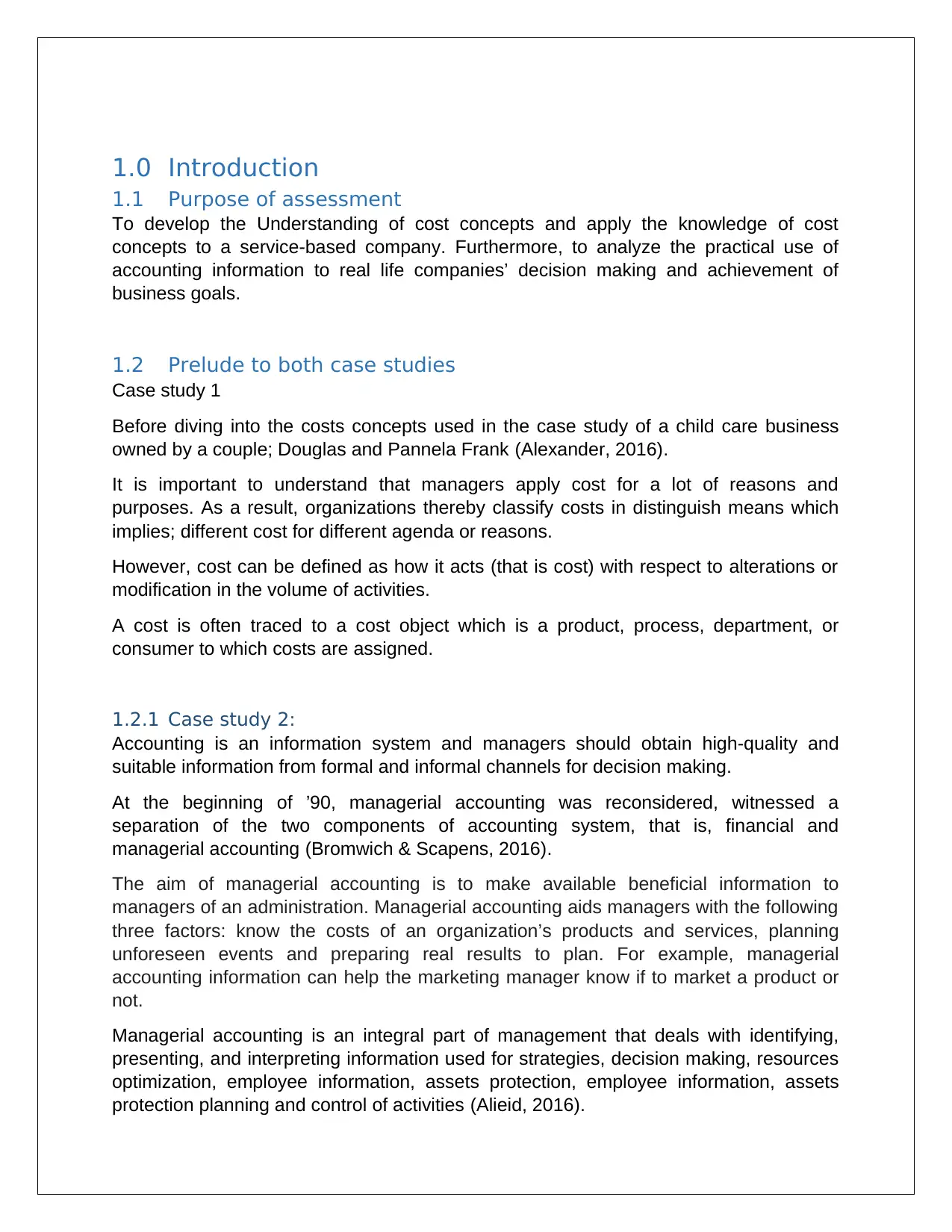
1.0 Introduction
1.1 Purpose of assessment
To develop the Understanding of cost concepts and apply the knowledge of cost
concepts to a service-based company. Furthermore, to analyze the practical use of
accounting information to real life companies’ decision making and achievement of
business goals.
1.2 Prelude to both case studies
Case study 1
Before diving into the costs concepts used in the case study of a child care business
owned by a couple; Douglas and Pannela Frank (Alexander, 2016).
It is important to understand that managers apply cost for a lot of reasons and
purposes. As a result, organizations thereby classify costs in distinguish means which
implies; different cost for different agenda or reasons.
However, cost can be defined as how it acts (that is cost) with respect to alterations or
modification in the volume of activities.
A cost is often traced to a cost object which is a product, process, department, or
consumer to which costs are assigned.
1.2.1 Case study 2:
Accounting is an information system and managers should obtain high-quality and
suitable information from formal and informal channels for decision making.
At the beginning of ’90, managerial accounting was reconsidered, witnessed a
separation of the two components of accounting system, that is, financial and
managerial accounting (Bromwich & Scapens, 2016).
The aim of managerial accounting is to make available beneficial information to
managers of an administration. Managerial accounting aids managers with the following
three factors: know the costs of an organization’s products and services, planning
unforeseen events and preparing real results to plan. For example, managerial
accounting information can help the marketing manager know if to market a product or
not.
Managerial accounting is an integral part of management that deals with identifying,
presenting, and interpreting information used for strategies, decision making, resources
optimization, employee information, assets protection, employee information, assets
protection planning and control of activities (Alieid, 2016).
1.1 Purpose of assessment
To develop the Understanding of cost concepts and apply the knowledge of cost
concepts to a service-based company. Furthermore, to analyze the practical use of
accounting information to real life companies’ decision making and achievement of
business goals.
1.2 Prelude to both case studies
Case study 1
Before diving into the costs concepts used in the case study of a child care business
owned by a couple; Douglas and Pannela Frank (Alexander, 2016).
It is important to understand that managers apply cost for a lot of reasons and
purposes. As a result, organizations thereby classify costs in distinguish means which
implies; different cost for different agenda or reasons.
However, cost can be defined as how it acts (that is cost) with respect to alterations or
modification in the volume of activities.
A cost is often traced to a cost object which is a product, process, department, or
consumer to which costs are assigned.
1.2.1 Case study 2:
Accounting is an information system and managers should obtain high-quality and
suitable information from formal and informal channels for decision making.
At the beginning of ’90, managerial accounting was reconsidered, witnessed a
separation of the two components of accounting system, that is, financial and
managerial accounting (Bromwich & Scapens, 2016).
The aim of managerial accounting is to make available beneficial information to
managers of an administration. Managerial accounting aids managers with the following
three factors: know the costs of an organization’s products and services, planning
unforeseen events and preparing real results to plan. For example, managerial
accounting information can help the marketing manager know if to market a product or
not.
Managerial accounting is an integral part of management that deals with identifying,
presenting, and interpreting information used for strategies, decision making, resources
optimization, employee information, assets protection, employee information, assets
protection planning and control of activities (Alieid, 2016).
⊘ This is a preview!⊘
Do you want full access?
Subscribe today to unlock all pages.

Trusted by 1+ million students worldwide
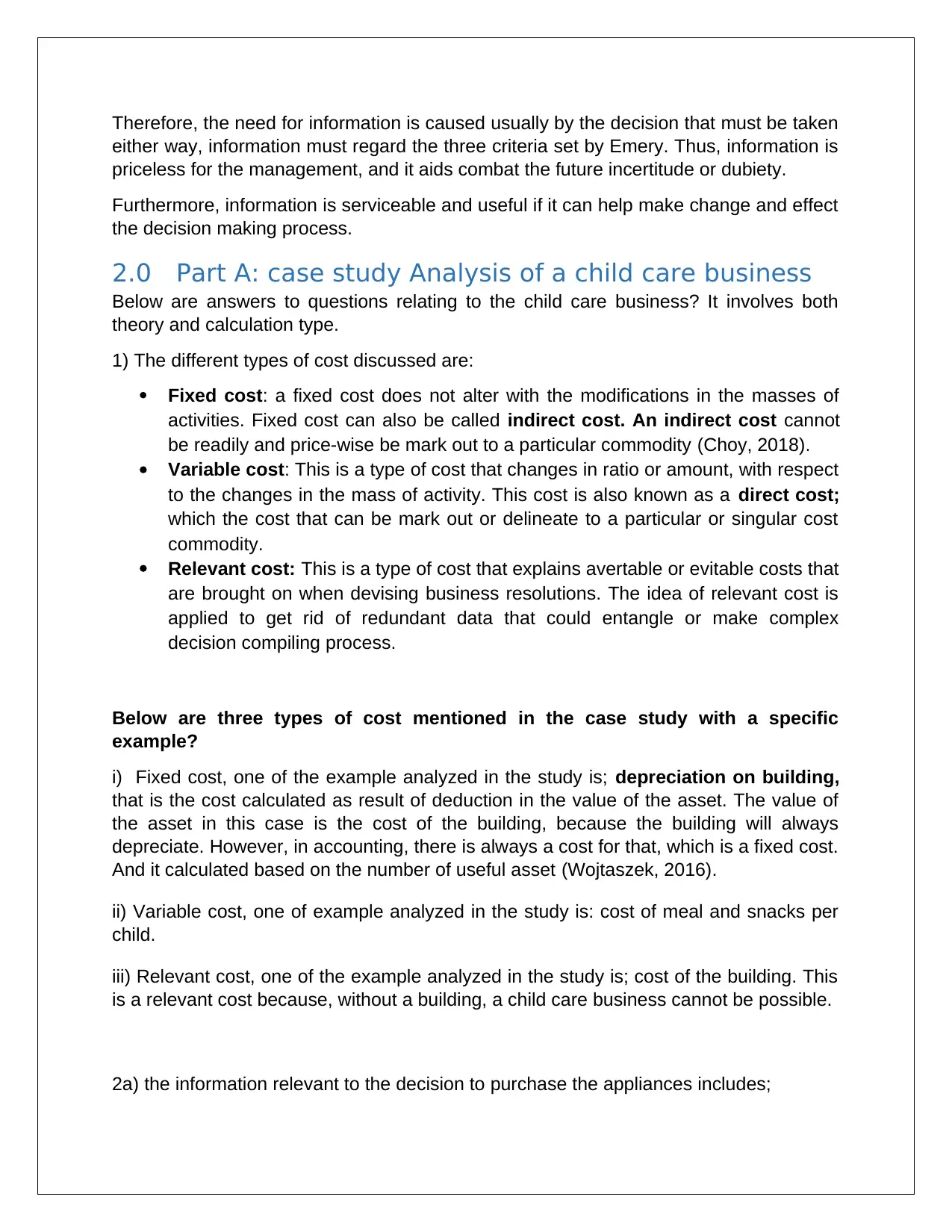
Therefore, the need for information is caused usually by the decision that must be taken
either way, information must regard the three criteria set by Emery. Thus, information is
priceless for the management, and it aids combat the future incertitude or dubiety.
Furthermore, information is serviceable and useful if it can help make change and effect
the decision making process.
2.0 Part A: case study Analysis of a child care business
Below are answers to questions relating to the child care business? It involves both
theory and calculation type.
1) The different types of cost discussed are:
Fixed cost: a fixed cost does not alter with the modifications in the masses of
activities. Fixed cost can also be called indirect cost. An indirect cost cannot
be readily and price-wise be mark out to a particular commodity (Choy, 2018).
Variable cost: This is a type of cost that changes in ratio or amount, with respect
to the changes in the mass of activity. This cost is also known as a direct cost;
which the cost that can be mark out or delineate to a particular or singular cost
commodity.
Relevant cost: This is a type of cost that explains avertable or evitable costs that
are brought on when devising business resolutions. The idea of relevant cost is
applied to get rid of redundant data that could entangle or make complex
decision compiling process.
Below are three types of cost mentioned in the case study with a specific
example?
i) Fixed cost, one of the example analyzed in the study is; depreciation on building,
that is the cost calculated as result of deduction in the value of the asset. The value of
the asset in this case is the cost of the building, because the building will always
depreciate. However, in accounting, there is always a cost for that, which is a fixed cost.
And it calculated based on the number of useful asset (Wojtaszek, 2016).
ii) Variable cost, one of example analyzed in the study is: cost of meal and snacks per
child.
iii) Relevant cost, one of the example analyzed in the study is; cost of the building. This
is a relevant cost because, without a building, a child care business cannot be possible.
2a) the information relevant to the decision to purchase the appliances includes;
either way, information must regard the three criteria set by Emery. Thus, information is
priceless for the management, and it aids combat the future incertitude or dubiety.
Furthermore, information is serviceable and useful if it can help make change and effect
the decision making process.
2.0 Part A: case study Analysis of a child care business
Below are answers to questions relating to the child care business? It involves both
theory and calculation type.
1) The different types of cost discussed are:
Fixed cost: a fixed cost does not alter with the modifications in the masses of
activities. Fixed cost can also be called indirect cost. An indirect cost cannot
be readily and price-wise be mark out to a particular commodity (Choy, 2018).
Variable cost: This is a type of cost that changes in ratio or amount, with respect
to the changes in the mass of activity. This cost is also known as a direct cost;
which the cost that can be mark out or delineate to a particular or singular cost
commodity.
Relevant cost: This is a type of cost that explains avertable or evitable costs that
are brought on when devising business resolutions. The idea of relevant cost is
applied to get rid of redundant data that could entangle or make complex
decision compiling process.
Below are three types of cost mentioned in the case study with a specific
example?
i) Fixed cost, one of the example analyzed in the study is; depreciation on building,
that is the cost calculated as result of deduction in the value of the asset. The value of
the asset in this case is the cost of the building, because the building will always
depreciate. However, in accounting, there is always a cost for that, which is a fixed cost.
And it calculated based on the number of useful asset (Wojtaszek, 2016).
ii) Variable cost, one of example analyzed in the study is: cost of meal and snacks per
child.
iii) Relevant cost, one of the example analyzed in the study is; cost of the building. This
is a relevant cost because, without a building, a child care business cannot be possible.
2a) the information relevant to the decision to purchase the appliances includes;
Paraphrase This Document
Need a fresh take? Get an instant paraphrase of this document with our AI Paraphraser
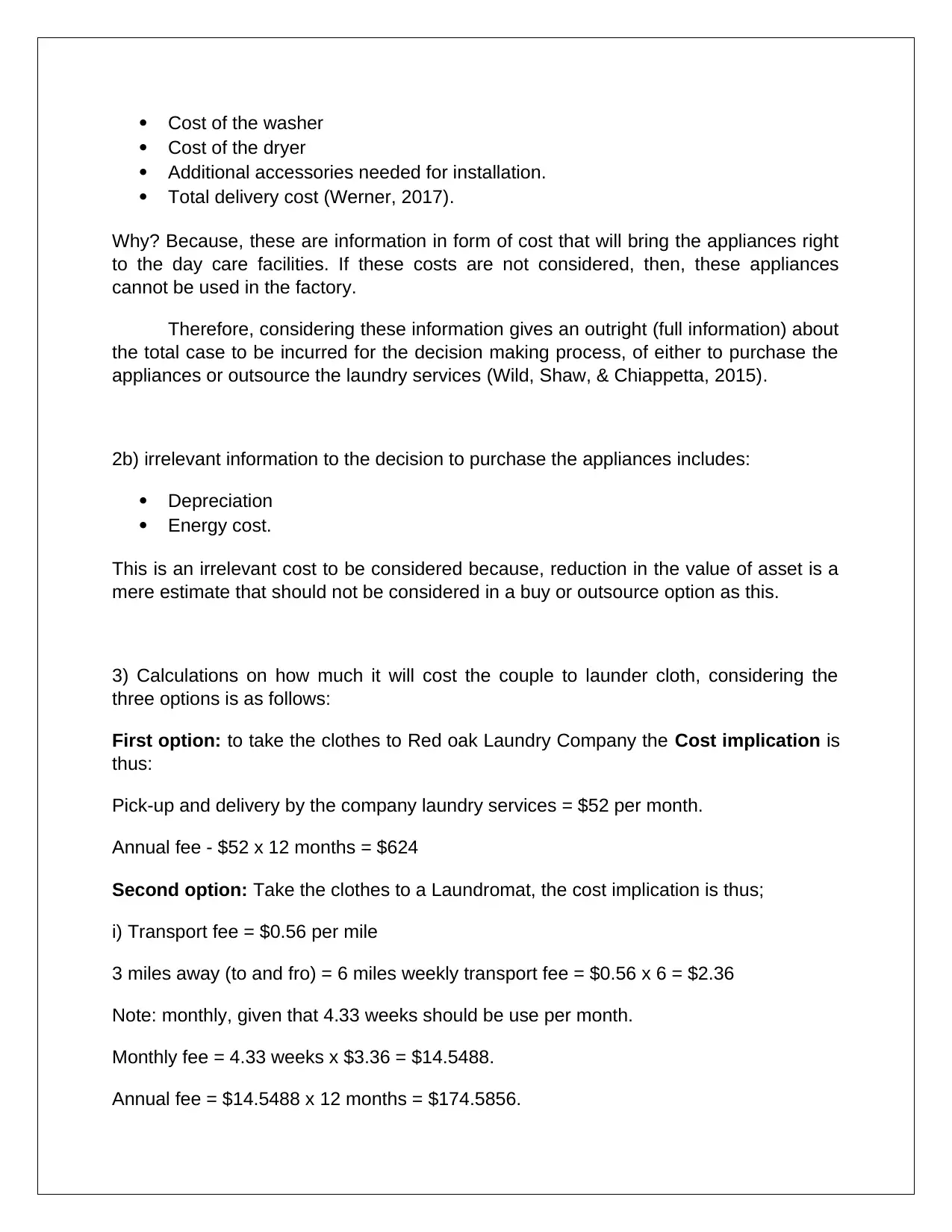
Cost of the washer
Cost of the dryer
Additional accessories needed for installation.
Total delivery cost (Werner, 2017).
Why? Because, these are information in form of cost that will bring the appliances right
to the day care facilities. If these costs are not considered, then, these appliances
cannot be used in the factory.
Therefore, considering these information gives an outright (full information) about
the total case to be incurred for the decision making process, of either to purchase the
appliances or outsource the laundry services (Wild, Shaw, & Chiappetta, 2015).
2b) irrelevant information to the decision to purchase the appliances includes:
Depreciation
Energy cost.
This is an irrelevant cost to be considered because, reduction in the value of asset is a
mere estimate that should not be considered in a buy or outsource option as this.
3) Calculations on how much it will cost the couple to launder cloth, considering the
three options is as follows:
First option: to take the clothes to Red oak Laundry Company the Cost implication is
thus:
Pick-up and delivery by the company laundry services = $52 per month.
Annual fee - $52 x 12 months = $624
Second option: Take the clothes to a Laundromat, the cost implication is thus;
i) Transport fee = $0.56 per mile
3 miles away (to and fro) = 6 miles weekly transport fee = $0.56 x 6 = $2.36
Note: monthly, given that 4.33 weeks should be use per month.
Monthly fee = 4.33 weeks x $3.36 = $14.5488.
Annual fee = $14.5488 x 12 months = $174.5856.
Cost of the dryer
Additional accessories needed for installation.
Total delivery cost (Werner, 2017).
Why? Because, these are information in form of cost that will bring the appliances right
to the day care facilities. If these costs are not considered, then, these appliances
cannot be used in the factory.
Therefore, considering these information gives an outright (full information) about
the total case to be incurred for the decision making process, of either to purchase the
appliances or outsource the laundry services (Wild, Shaw, & Chiappetta, 2015).
2b) irrelevant information to the decision to purchase the appliances includes:
Depreciation
Energy cost.
This is an irrelevant cost to be considered because, reduction in the value of asset is a
mere estimate that should not be considered in a buy or outsource option as this.
3) Calculations on how much it will cost the couple to launder cloth, considering the
three options is as follows:
First option: to take the clothes to Red oak Laundry Company the Cost implication is
thus:
Pick-up and delivery by the company laundry services = $52 per month.
Annual fee - $52 x 12 months = $624
Second option: Take the clothes to a Laundromat, the cost implication is thus;
i) Transport fee = $0.56 per mile
3 miles away (to and fro) = 6 miles weekly transport fee = $0.56 x 6 = $2.36
Note: monthly, given that 4.33 weeks should be use per month.
Monthly fee = 4.33 weeks x $3.36 = $14.5488.
Annual fee = $14.5488 x 12 months = $174.5856.
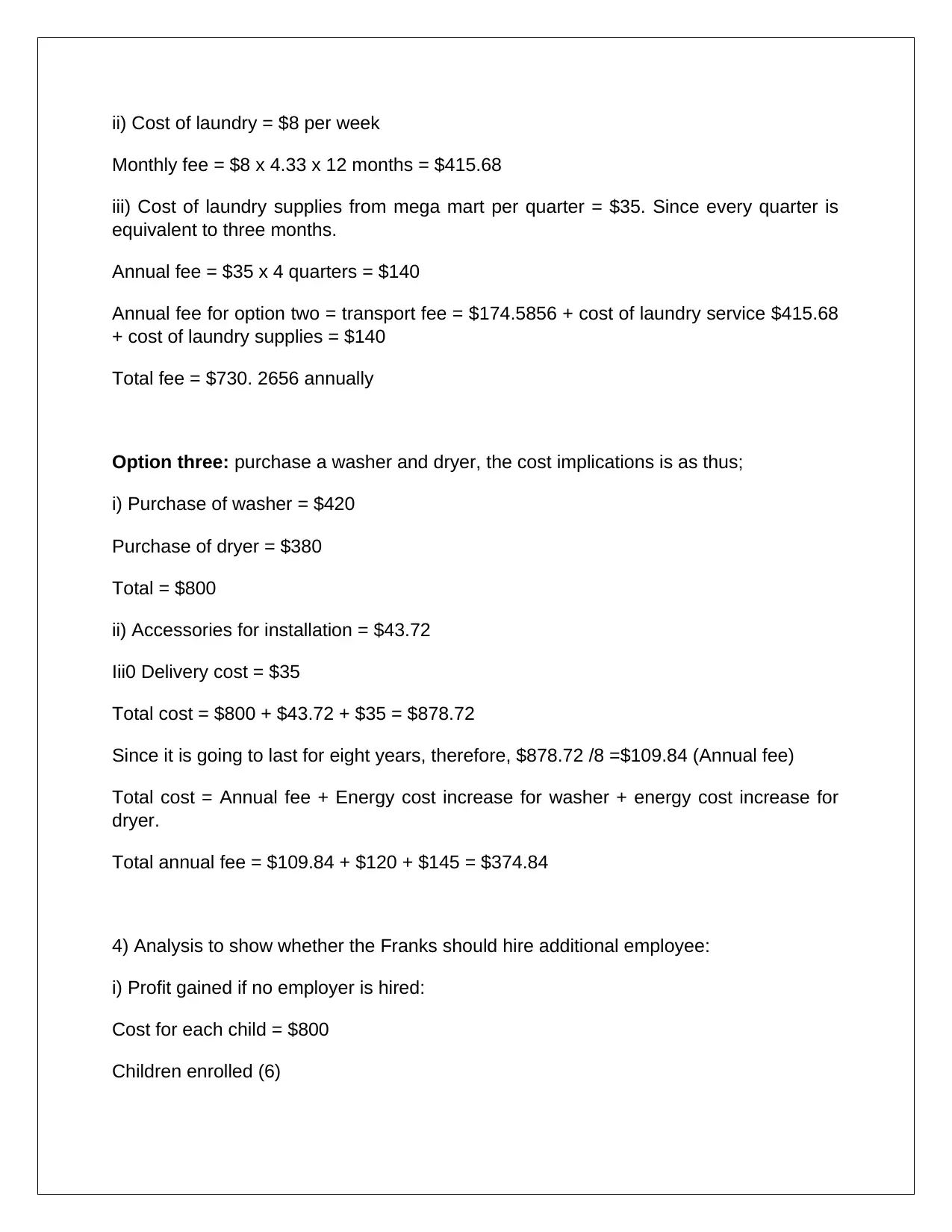
ii) Cost of laundry = $8 per week
Monthly fee = $8 x 4.33 x 12 months = $415.68
iii) Cost of laundry supplies from mega mart per quarter = $35. Since every quarter is
equivalent to three months.
Annual fee = $35 x 4 quarters = $140
Annual fee for option two = transport fee = $174.5856 + cost of laundry service $415.68
+ cost of laundry supplies = $140
Total fee = $730. 2656 annually
Option three: purchase a washer and dryer, the cost implications is as thus;
i) Purchase of washer = $420
Purchase of dryer = $380
Total = $800
ii) Accessories for installation = $43.72
Iii0 Delivery cost = $35
Total cost = $800 + $43.72 + $35 = $878.72
Since it is going to last for eight years, therefore, $878.72 /8 =$109.84 (Annual fee)
Total cost = Annual fee + Energy cost increase for washer + energy cost increase for
dryer.
Total annual fee = $109.84 + $120 + $145 = $374.84
4) Analysis to show whether the Franks should hire additional employee:
i) Profit gained if no employer is hired:
Cost for each child = $800
Children enrolled (6)
Monthly fee = $8 x 4.33 x 12 months = $415.68
iii) Cost of laundry supplies from mega mart per quarter = $35. Since every quarter is
equivalent to three months.
Annual fee = $35 x 4 quarters = $140
Annual fee for option two = transport fee = $174.5856 + cost of laundry service $415.68
+ cost of laundry supplies = $140
Total fee = $730. 2656 annually
Option three: purchase a washer and dryer, the cost implications is as thus;
i) Purchase of washer = $420
Purchase of dryer = $380
Total = $800
ii) Accessories for installation = $43.72
Iii0 Delivery cost = $35
Total cost = $800 + $43.72 + $35 = $878.72
Since it is going to last for eight years, therefore, $878.72 /8 =$109.84 (Annual fee)
Total cost = Annual fee + Energy cost increase for washer + energy cost increase for
dryer.
Total annual fee = $109.84 + $120 + $145 = $374.84
4) Analysis to show whether the Franks should hire additional employee:
i) Profit gained if no employer is hired:
Cost for each child = $800
Children enrolled (6)
⊘ This is a preview!⊘
Do you want full access?
Subscribe today to unlock all pages.

Trusted by 1+ million students worldwide
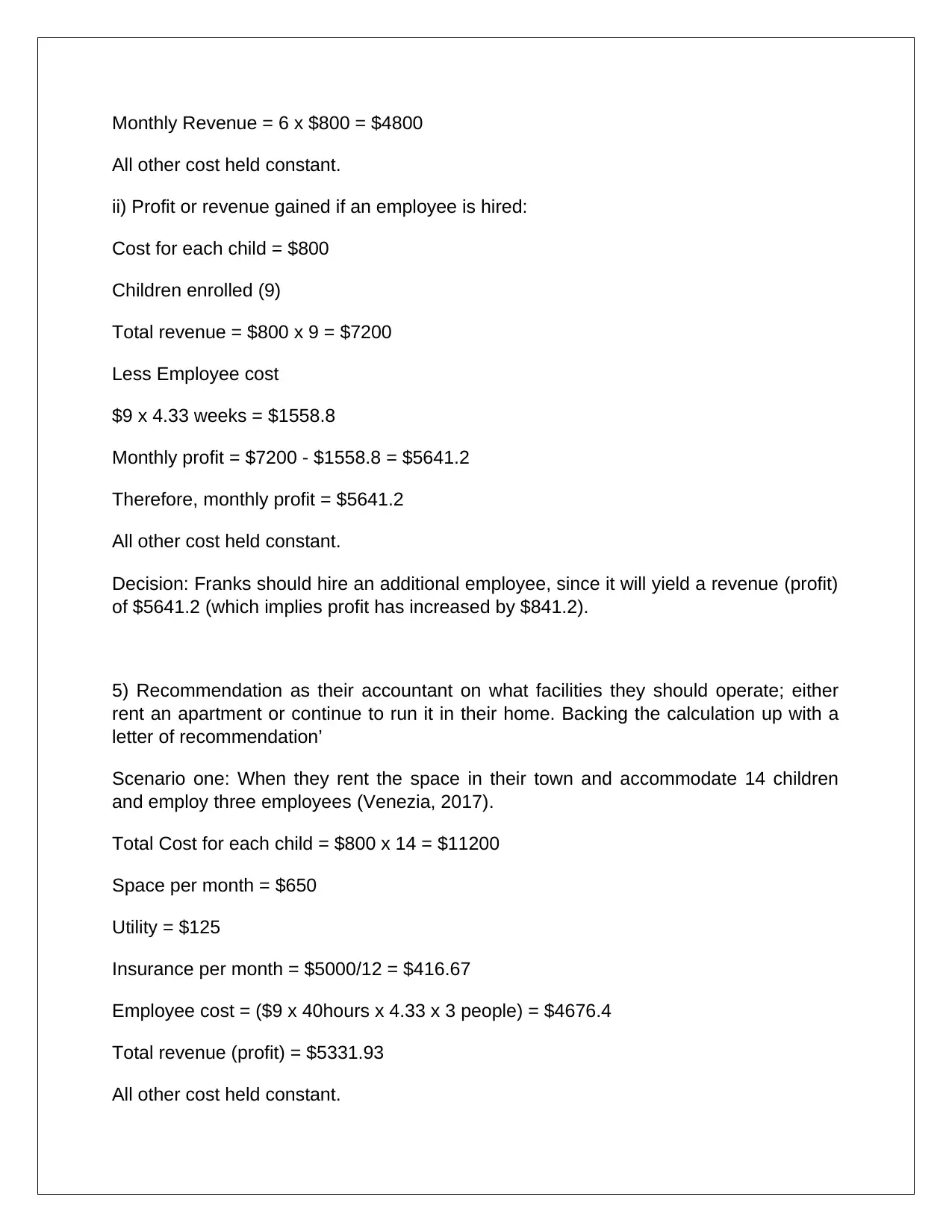
Monthly Revenue = 6 x $800 = $4800
All other cost held constant.
ii) Profit or revenue gained if an employee is hired:
Cost for each child = $800
Children enrolled (9)
Total revenue = $800 x 9 = $7200
Less Employee cost
$9 x 4.33 weeks = $1558.8
Monthly profit = $7200 - $1558.8 = $5641.2
Therefore, monthly profit = $5641.2
All other cost held constant.
Decision: Franks should hire an additional employee, since it will yield a revenue (profit)
of $5641.2 (which implies profit has increased by $841.2).
5) Recommendation as their accountant on what facilities they should operate; either
rent an apartment or continue to run it in their home. Backing the calculation up with a
letter of recommendation’
Scenario one: When they rent the space in their town and accommodate 14 children
and employ three employees (Venezia, 2017).
Total Cost for each child = $800 x 14 = $11200
Space per month = $650
Utility = $125
Insurance per month = $5000/12 = $416.67
Employee cost = ($9 x 40hours x 4.33 x 3 people) = $4676.4
Total revenue (profit) = $5331.93
All other cost held constant.
All other cost held constant.
ii) Profit or revenue gained if an employee is hired:
Cost for each child = $800
Children enrolled (9)
Total revenue = $800 x 9 = $7200
Less Employee cost
$9 x 4.33 weeks = $1558.8
Monthly profit = $7200 - $1558.8 = $5641.2
Therefore, monthly profit = $5641.2
All other cost held constant.
Decision: Franks should hire an additional employee, since it will yield a revenue (profit)
of $5641.2 (which implies profit has increased by $841.2).
5) Recommendation as their accountant on what facilities they should operate; either
rent an apartment or continue to run it in their home. Backing the calculation up with a
letter of recommendation’
Scenario one: When they rent the space in their town and accommodate 14 children
and employ three employees (Venezia, 2017).
Total Cost for each child = $800 x 14 = $11200
Space per month = $650
Utility = $125
Insurance per month = $5000/12 = $416.67
Employee cost = ($9 x 40hours x 4.33 x 3 people) = $4676.4
Total revenue (profit) = $5331.93
All other cost held constant.
Paraphrase This Document
Need a fresh take? Get an instant paraphrase of this document with our AI Paraphraser
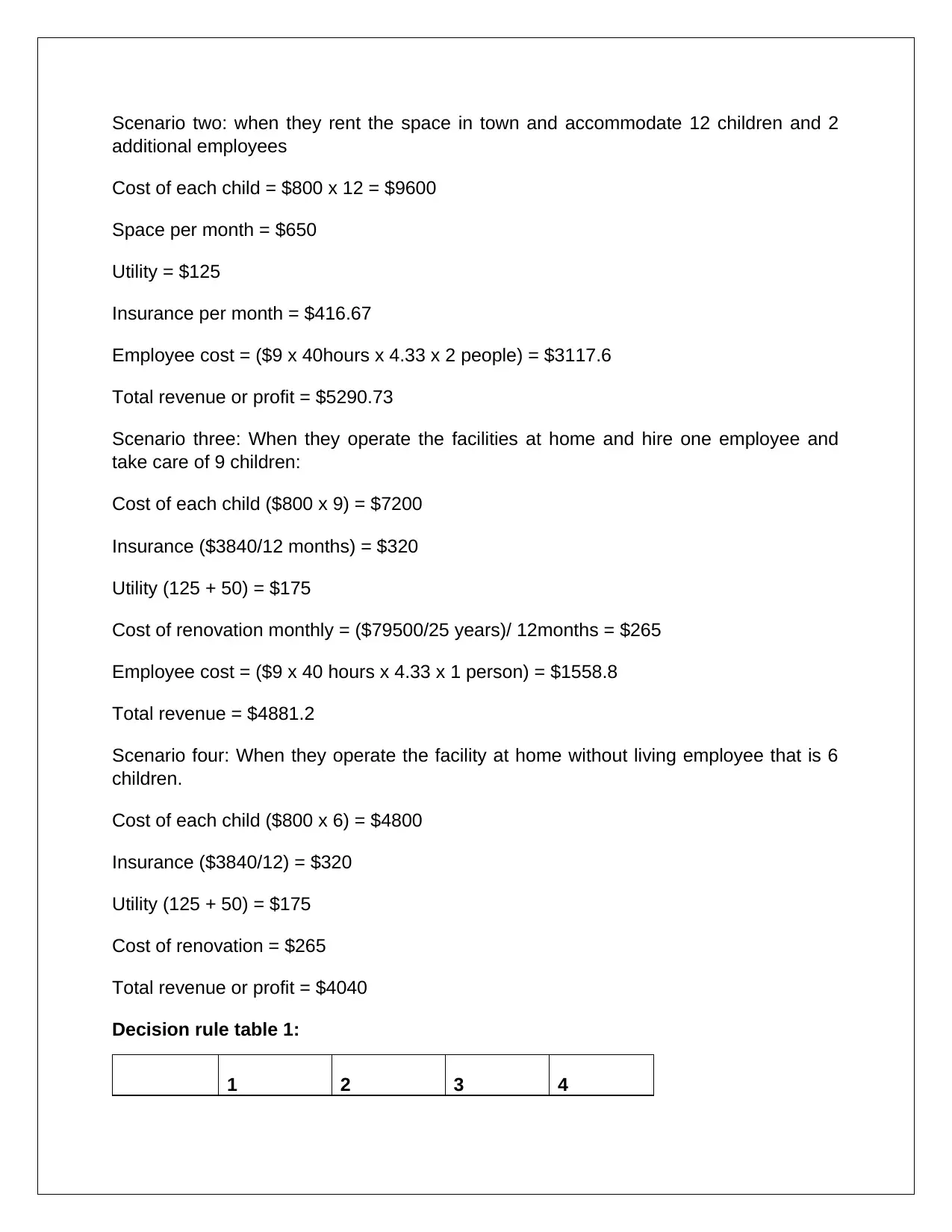
Scenario two: when they rent the space in town and accommodate 12 children and 2
additional employees
Cost of each child = $800 x 12 = $9600
Space per month = $650
Utility = $125
Insurance per month = $416.67
Employee cost = ($9 x 40hours x 4.33 x 2 people) = $3117.6
Total revenue or profit = $5290.73
Scenario three: When they operate the facilities at home and hire one employee and
take care of 9 children:
Cost of each child ($800 x 9) = $7200
Insurance ($3840/12 months) = $320
Utility (125 + 50) = $175
Cost of renovation monthly = ($79500/25 years)/ 12months = $265
Employee cost = ($9 x 40 hours x 4.33 x 1 person) = $1558.8
Total revenue = $4881.2
Scenario four: When they operate the facility at home without living employee that is 6
children.
Cost of each child ($800 x 6) = $4800
Insurance ($3840/12) = $320
Utility (125 + 50) = $175
Cost of renovation = $265
Total revenue or profit = $4040
Decision rule table 1:
1 2 3 4
additional employees
Cost of each child = $800 x 12 = $9600
Space per month = $650
Utility = $125
Insurance per month = $416.67
Employee cost = ($9 x 40hours x 4.33 x 2 people) = $3117.6
Total revenue or profit = $5290.73
Scenario three: When they operate the facilities at home and hire one employee and
take care of 9 children:
Cost of each child ($800 x 9) = $7200
Insurance ($3840/12 months) = $320
Utility (125 + 50) = $175
Cost of renovation monthly = ($79500/25 years)/ 12months = $265
Employee cost = ($9 x 40 hours x 4.33 x 1 person) = $1558.8
Total revenue = $4881.2
Scenario four: When they operate the facility at home without living employee that is 6
children.
Cost of each child ($800 x 6) = $4800
Insurance ($3840/12) = $320
Utility (125 + 50) = $175
Cost of renovation = $265
Total revenue or profit = $4040
Decision rule table 1:
1 2 3 4
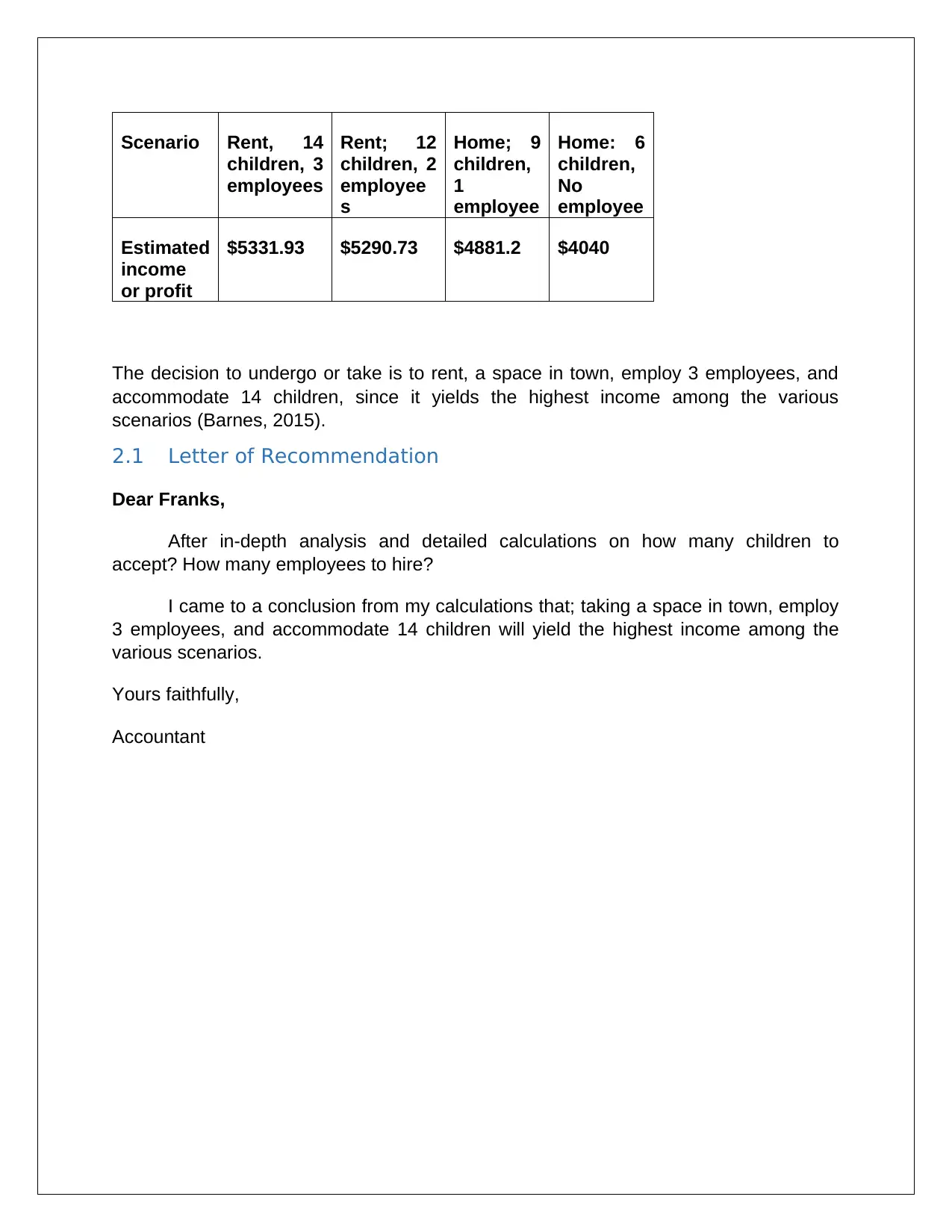
Scenario Rent, 14
children, 3
employees
Rent; 12
children, 2
employee
s
Home; 9
children,
1
employee
Home: 6
children,
No
employee
Estimated
income
or profit
$5331.93 $5290.73 $4881.2 $4040
The decision to undergo or take is to rent, a space in town, employ 3 employees, and
accommodate 14 children, since it yields the highest income among the various
scenarios (Barnes, 2015).
2.1 Letter of Recommendation
Dear Franks,
After in-depth analysis and detailed calculations on how many children to
accept? How many employees to hire?
I came to a conclusion from my calculations that; taking a space in town, employ
3 employees, and accommodate 14 children will yield the highest income among the
various scenarios.
Yours faithfully,
Accountant
children, 3
employees
Rent; 12
children, 2
employee
s
Home; 9
children,
1
employee
Home: 6
children,
No
employee
Estimated
income
or profit
$5331.93 $5290.73 $4881.2 $4040
The decision to undergo or take is to rent, a space in town, employ 3 employees, and
accommodate 14 children, since it yields the highest income among the various
scenarios (Barnes, 2015).
2.1 Letter of Recommendation
Dear Franks,
After in-depth analysis and detailed calculations on how many children to
accept? How many employees to hire?
I came to a conclusion from my calculations that; taking a space in town, employ
3 employees, and accommodate 14 children will yield the highest income among the
various scenarios.
Yours faithfully,
Accountant
⊘ This is a preview!⊘
Do you want full access?
Subscribe today to unlock all pages.

Trusted by 1+ million students worldwide
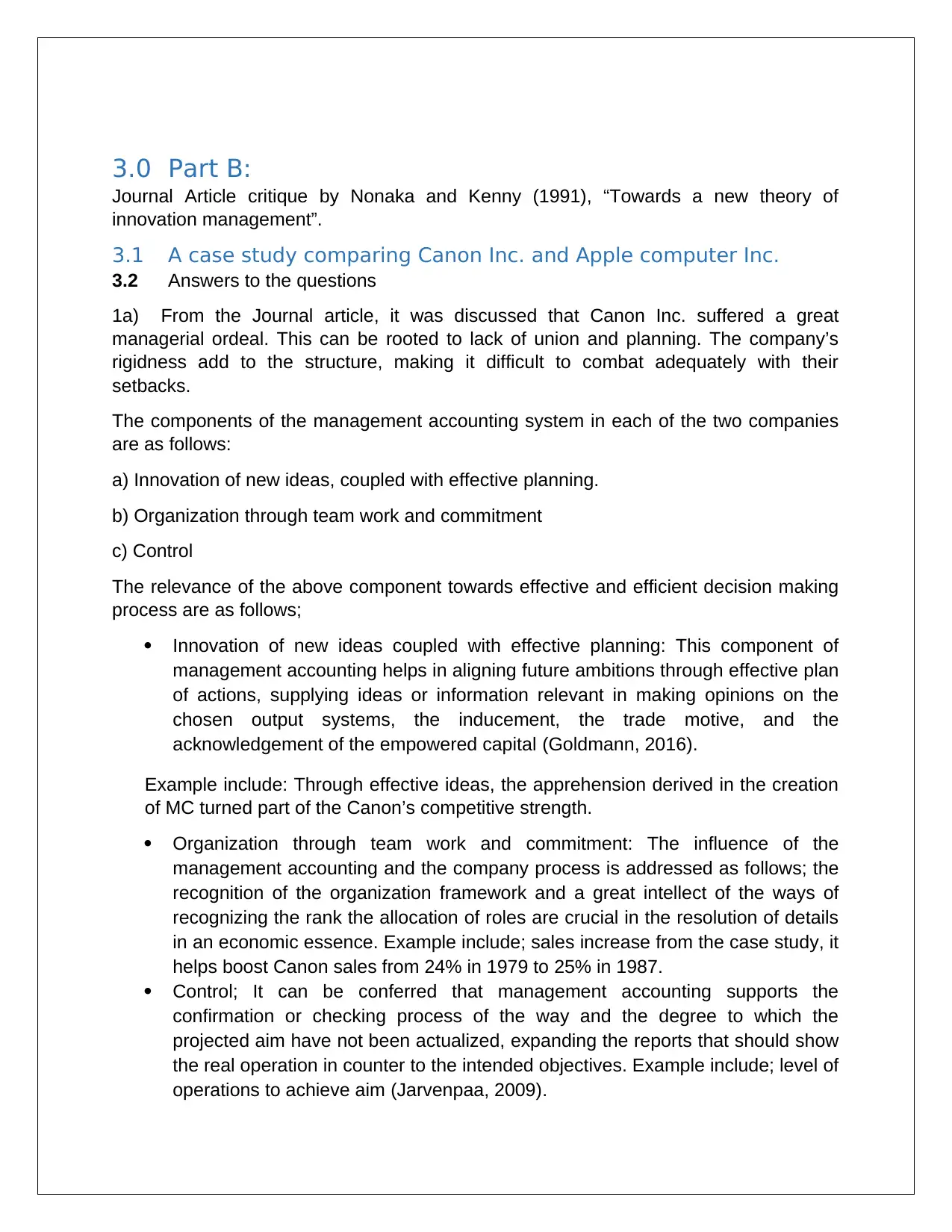
3.0 Part B:
Journal Article critique by Nonaka and Kenny (1991), “Towards a new theory of
innovation management”.
3.1 A case study comparing Canon Inc. and Apple computer Inc.
3.2 Answers to the questions
1a) From the Journal article, it was discussed that Canon Inc. suffered a great
managerial ordeal. This can be rooted to lack of union and planning. The company’s
rigidness add to the structure, making it difficult to combat adequately with their
setbacks.
The components of the management accounting system in each of the two companies
are as follows:
a) Innovation of new ideas, coupled with effective planning.
b) Organization through team work and commitment
c) Control
The relevance of the above component towards effective and efficient decision making
process are as follows;
Innovation of new ideas coupled with effective planning: This component of
management accounting helps in aligning future ambitions through effective plan
of actions, supplying ideas or information relevant in making opinions on the
chosen output systems, the inducement, the trade motive, and the
acknowledgement of the empowered capital (Goldmann, 2016).
Example include: Through effective ideas, the apprehension derived in the creation
of MC turned part of the Canon’s competitive strength.
Organization through team work and commitment: The influence of the
management accounting and the company process is addressed as follows; the
recognition of the organization framework and a great intellect of the ways of
recognizing the rank the allocation of roles are crucial in the resolution of details
in an economic essence. Example include; sales increase from the case study, it
helps boost Canon sales from 24% in 1979 to 25% in 1987.
Control; It can be conferred that management accounting supports the
confirmation or checking process of the way and the degree to which the
projected aim have not been actualized, expanding the reports that should show
the real operation in counter to the intended objectives. Example include; level of
operations to achieve aim (Jarvenpaa, 2009).
Journal Article critique by Nonaka and Kenny (1991), “Towards a new theory of
innovation management”.
3.1 A case study comparing Canon Inc. and Apple computer Inc.
3.2 Answers to the questions
1a) From the Journal article, it was discussed that Canon Inc. suffered a great
managerial ordeal. This can be rooted to lack of union and planning. The company’s
rigidness add to the structure, making it difficult to combat adequately with their
setbacks.
The components of the management accounting system in each of the two companies
are as follows:
a) Innovation of new ideas, coupled with effective planning.
b) Organization through team work and commitment
c) Control
The relevance of the above component towards effective and efficient decision making
process are as follows;
Innovation of new ideas coupled with effective planning: This component of
management accounting helps in aligning future ambitions through effective plan
of actions, supplying ideas or information relevant in making opinions on the
chosen output systems, the inducement, the trade motive, and the
acknowledgement of the empowered capital (Goldmann, 2016).
Example include: Through effective ideas, the apprehension derived in the creation
of MC turned part of the Canon’s competitive strength.
Organization through team work and commitment: The influence of the
management accounting and the company process is addressed as follows; the
recognition of the organization framework and a great intellect of the ways of
recognizing the rank the allocation of roles are crucial in the resolution of details
in an economic essence. Example include; sales increase from the case study, it
helps boost Canon sales from 24% in 1979 to 25% in 1987.
Control; It can be conferred that management accounting supports the
confirmation or checking process of the way and the degree to which the
projected aim have not been actualized, expanding the reports that should show
the real operation in counter to the intended objectives. Example include; level of
operations to achieve aim (Jarvenpaa, 2009).
Paraphrase This Document
Need a fresh take? Get an instant paraphrase of this document with our AI Paraphraser
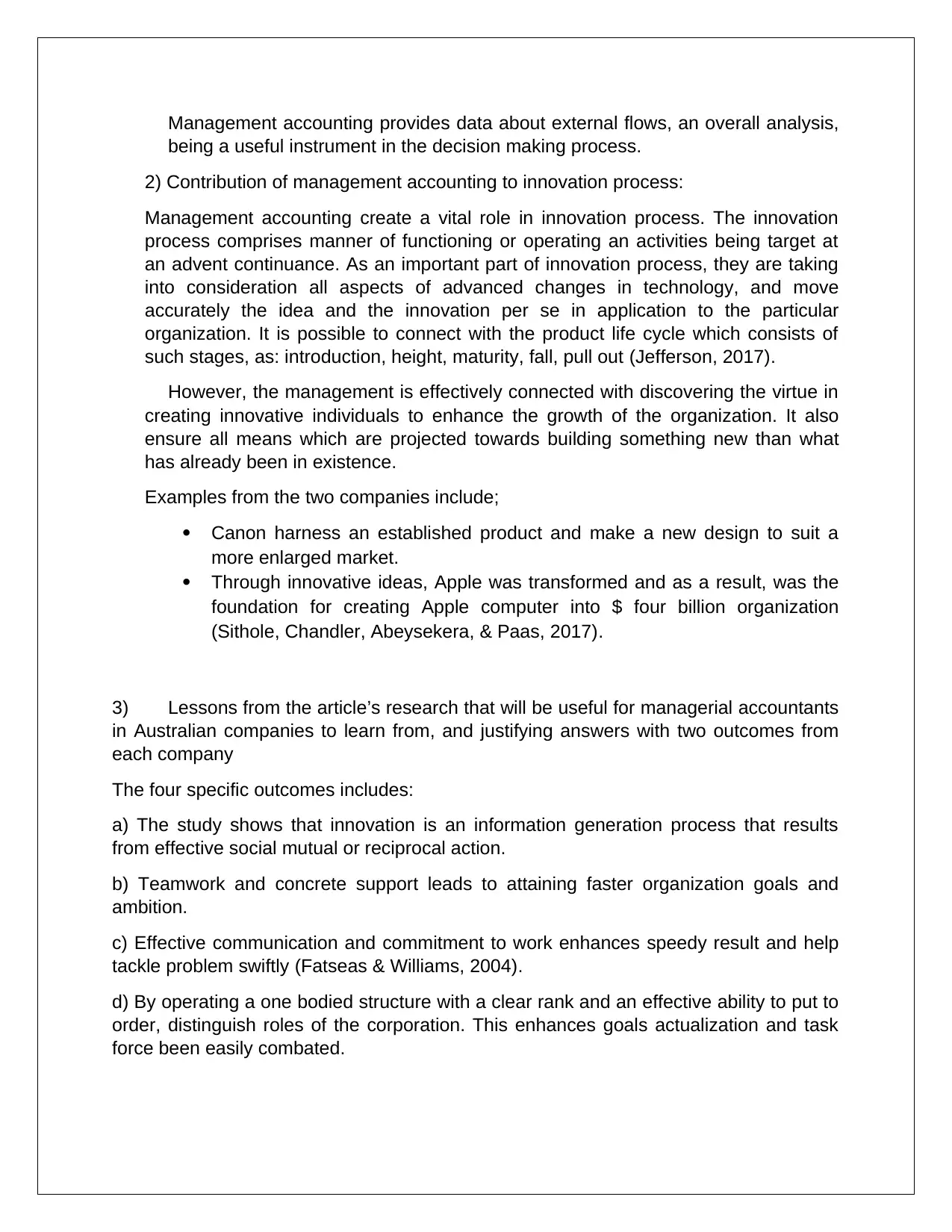
Management accounting provides data about external flows, an overall analysis,
being a useful instrument in the decision making process.
2) Contribution of management accounting to innovation process:
Management accounting create a vital role in innovation process. The innovation
process comprises manner of functioning or operating an activities being target at
an advent continuance. As an important part of innovation process, they are taking
into consideration all aspects of advanced changes in technology, and move
accurately the idea and the innovation per se in application to the particular
organization. It is possible to connect with the product life cycle which consists of
such stages, as: introduction, height, maturity, fall, pull out (Jefferson, 2017).
However, the management is effectively connected with discovering the virtue in
creating innovative individuals to enhance the growth of the organization. It also
ensure all means which are projected towards building something new than what
has already been in existence.
Examples from the two companies include;
Canon harness an established product and make a new design to suit a
more enlarged market.
Through innovative ideas, Apple was transformed and as a result, was the
foundation for creating Apple computer into $ four billion organization
(Sithole, Chandler, Abeysekera, & Paas, 2017).
3) Lessons from the article’s research that will be useful for managerial accountants
in Australian companies to learn from, and justifying answers with two outcomes from
each company
The four specific outcomes includes:
a) The study shows that innovation is an information generation process that results
from effective social mutual or reciprocal action.
b) Teamwork and concrete support leads to attaining faster organization goals and
ambition.
c) Effective communication and commitment to work enhances speedy result and help
tackle problem swiftly (Fatseas & Williams, 2004).
d) By operating a one bodied structure with a clear rank and an effective ability to put to
order, distinguish roles of the corporation. This enhances goals actualization and task
force been easily combated.
being a useful instrument in the decision making process.
2) Contribution of management accounting to innovation process:
Management accounting create a vital role in innovation process. The innovation
process comprises manner of functioning or operating an activities being target at
an advent continuance. As an important part of innovation process, they are taking
into consideration all aspects of advanced changes in technology, and move
accurately the idea and the innovation per se in application to the particular
organization. It is possible to connect with the product life cycle which consists of
such stages, as: introduction, height, maturity, fall, pull out (Jefferson, 2017).
However, the management is effectively connected with discovering the virtue in
creating innovative individuals to enhance the growth of the organization. It also
ensure all means which are projected towards building something new than what
has already been in existence.
Examples from the two companies include;
Canon harness an established product and make a new design to suit a
more enlarged market.
Through innovative ideas, Apple was transformed and as a result, was the
foundation for creating Apple computer into $ four billion organization
(Sithole, Chandler, Abeysekera, & Paas, 2017).
3) Lessons from the article’s research that will be useful for managerial accountants
in Australian companies to learn from, and justifying answers with two outcomes from
each company
The four specific outcomes includes:
a) The study shows that innovation is an information generation process that results
from effective social mutual or reciprocal action.
b) Teamwork and concrete support leads to attaining faster organization goals and
ambition.
c) Effective communication and commitment to work enhances speedy result and help
tackle problem swiftly (Fatseas & Williams, 2004).
d) By operating a one bodied structure with a clear rank and an effective ability to put to
order, distinguish roles of the corporation. This enhances goals actualization and task
force been easily combated.
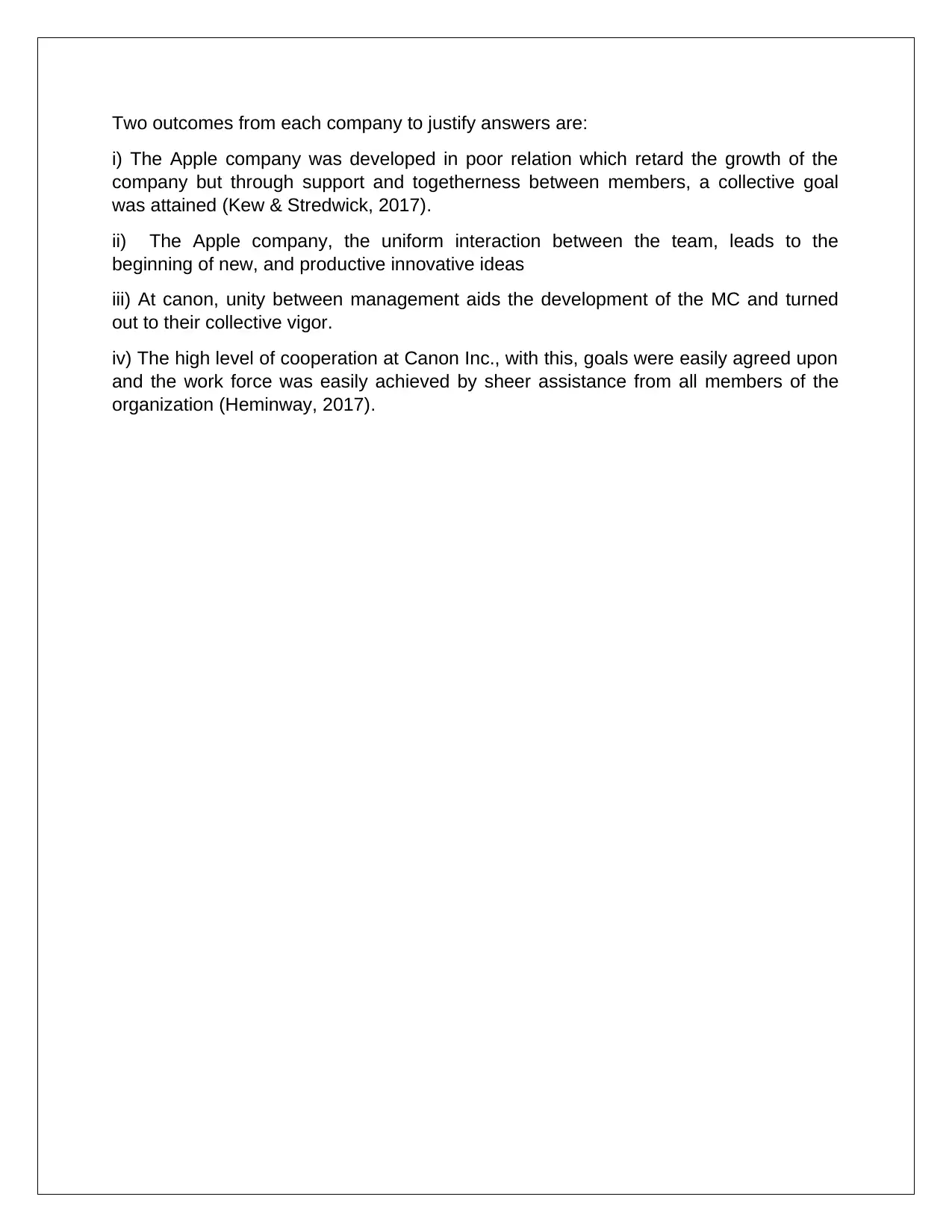
Two outcomes from each company to justify answers are:
i) The Apple company was developed in poor relation which retard the growth of the
company but through support and togetherness between members, a collective goal
was attained (Kew & Stredwick, 2017).
ii) The Apple company, the uniform interaction between the team, leads to the
beginning of new, and productive innovative ideas
iii) At canon, unity between management aids the development of the MC and turned
out to their collective vigor.
iv) The high level of cooperation at Canon Inc., with this, goals were easily agreed upon
and the work force was easily achieved by sheer assistance from all members of the
organization (Heminway, 2017).
i) The Apple company was developed in poor relation which retard the growth of the
company but through support and togetherness between members, a collective goal
was attained (Kew & Stredwick, 2017).
ii) The Apple company, the uniform interaction between the team, leads to the
beginning of new, and productive innovative ideas
iii) At canon, unity between management aids the development of the MC and turned
out to their collective vigor.
iv) The high level of cooperation at Canon Inc., with this, goals were easily agreed upon
and the work force was easily achieved by sheer assistance from all members of the
organization (Heminway, 2017).
⊘ This is a preview!⊘
Do you want full access?
Subscribe today to unlock all pages.

Trusted by 1+ million students worldwide
1 out of 14
Related Documents
Your All-in-One AI-Powered Toolkit for Academic Success.
+13062052269
info@desklib.com
Available 24*7 on WhatsApp / Email
![[object Object]](/_next/static/media/star-bottom.7253800d.svg)
Unlock your academic potential
Copyright © 2020–2025 A2Z Services. All Rights Reserved. Developed and managed by ZUCOL.





